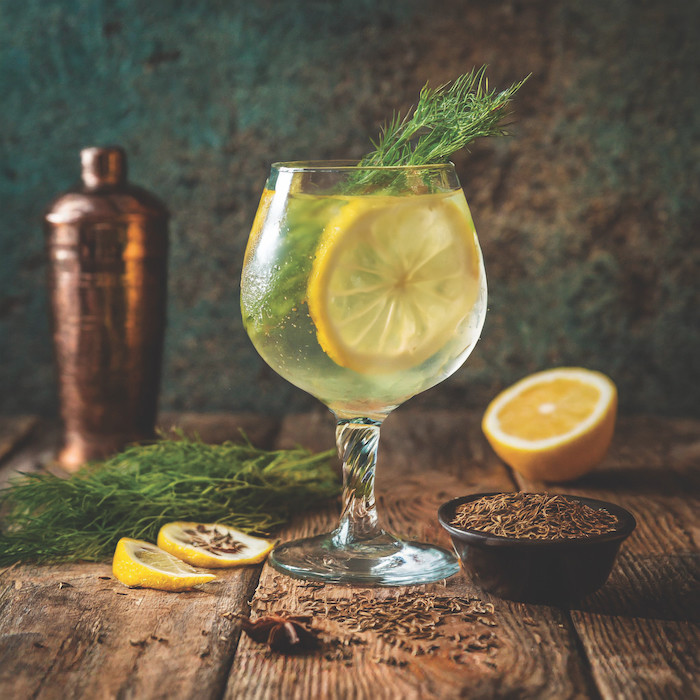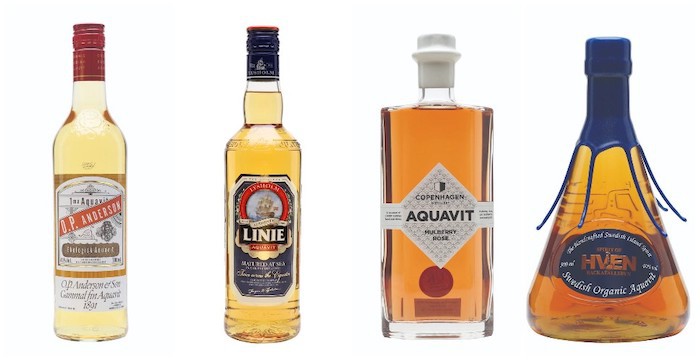
An ancient Scandinavian spirit little known outside of its native countries could be poised for a breakout, says Laura Foster.
What is it? Hailing from Scandinavia, aquavit is a spirit that sees neutral alcohol flavoured by herbs and spices during distillation. “All styles must be at least 37.5% abv and the main spices used in the distillation process must be caraway seeds and/or dill,” explains Atle Minothi, aquavit ambassador at Anora, a drinks brand house in the Nordic region.
Each producer country has a typical style for its aquavits, as Minothi outlines: “Norwegian aquavits must be cask matured and will therefore be influenced by the fl avours imparted by the casks, such as vanilla, caramel, and dried fruit, in addition to caraway and other spices used during distillation. Another well-known style is the Danish one. These aquavits are not cask matured but are often caraway-forward and taste of the spices used in distillation.
“The third style is Swedish aquavit. Since the Swedes often enjoy aquavit in the summer, typically with herring or crayfish, this style is milder and often served chilled. Swedes always use fennel in addition to the caraway or dill seeds. Even though the category is protected with a Geographical Indication, you are quite free to explore tastes in addition to the mandatory caraway and/or dill flavour.”
The spirit has a long history, with the first recorded mention of aquavit dating to a letter sent in 1531 in Norway. As Minothi explains, it was originally used for medicinal purposes, before being used during festive occasions, where it rapidly spread through the Nordics: “In Norway, production peaked in 1833 with an astonishing 11,000 small farm distilleries registered in a nation of only 900,000 inhabitants.”
The Himkok bar team in Oslo are passionate about aquavit, making their own and working to spread the gospel of the spirit both through their work in the bar and a partnership with Norwegian brand Linie, which has seen a batch of Himkok aquavit embark on a sea journey across the equator to age it. They are working to break the spirit out from the confines of its traditional drinking occasions.
“Aquavit is [drunk] when you celebrate something – Christmas, Easter or weddings,” says Maroš Dzurus, bar manager of Himkok. “Yes, it’s seen as a festive thing, and we are trying to promote it as a daily drink,” says Paul Voza, head of R&D at Himkok.
What’s out there?
OP Anderson is Sweden’s oldest aquavit brand, and is distributed by Amber Beverage UK. The Original (40% abv) has been made using the same recipe since 1891, with caraway, fennel and aniseed. It’s aged for six months, resulting in a palate of liquorice, fennel, leather, nutmeg and some cooling menthol. Klar (40% abv) takes the fl avours of the Original and adds dill seeds and lemon. Created to accompany fi sh, it has a soft, gently sweet palate with lifted citrus and grassy dill.

Amathus Drinks has an impressive range of aquavits available, including the below.
Norwegian brand Linie ages its aquavit casks by sending them on a four-month-long sea journey, crossing the equator twice. The main flavours within its Original (41.5% abv) are caraway and star anise, both of which are present on the palate, along with cinnamon, brown sugar, mint and dark chocolate.
Copenhagen Distillery’s Mulberry Rose (41% abv) is a more modern take on aquavit, infusing wheat spirit with mulberry, rose, dill, raspberry and marigold. The soft palate is all strawberries and cream with dry pencil shavings – a perfect ingredient for a summer cocktail.
Spirit of Hven from Sweden uses its own vodka as a base for its aquavit (40%), which is redistilled with caraway, lemon and orange peel, St John’s wort and rhubarb, before being aged in cask. The result is a refi ned, accessible palate, with citrus accompanied by sweet spice and caramel.
Looking beyond Scandinavia, the Orkney Gin Company makes an unaged Akvavit (41.5%). Distilled with caraway, orange, rosehips, star anise and vanilla, all these flavours ring out with crystal-clear precision. This product can be sourced directly from the distillery.
How to use it
The traditional way to enjoy aquavit in Scandinavia is to drink it neat as an accompaniment to food during celebratory meals. “If I was pairing with something like Linie Madeira Cask I’d go for fi sh – cod is very nice, or herring. For normal sherry cask then you want to pair with pork belly or smoked lamb,” says Voza.
As for mixing with aquavit, Dzurus believes it’s best to stick with the classics: “With unaged aquavit, you can do all the classic cocktails with gin. Instead of a gin and tonic you can do an aquavit and tonic. You don’t have the juniper, but you still have the spiciness and also citrus notes there. You can do a Negroni, Hanky Panky… With aged aquavit you can do an Old Fashioned. You don’t even need bitters, because you already have the spiciness coming from the aquavit, and you have the sweet notes. Just basically add simple syrup or a [sugar] cube and aquavit, and it’s done.”
With most products boasting soft, accessible palates and botanicals similar to gin, is it time for aquavit to break out of its food-pairing and Scandinavian confines, and take on the globe?


